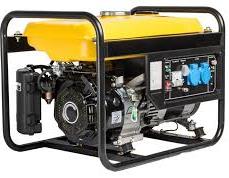An Alternating current (a.c) Generator is also refereed to as the alternator. An a.c generator is a device or machine that converts mechanical energy energy into electrical energy. It does this by rotating conductors through magnetic fields.
The figure below illustrates a simple generator. It is made of curved permanent rectangular magnetic poles, slip rings, a conductor made into a loop, and carbon brushes.

The poles of magnets are curved so that the magnetic field is radial. Current enters and leaves the coil through the brushes which are pressing against the slip rings.
Carbon brushes are preferred because they are good conductor, slippery to allow the wire slide along with ease and acts as a lubricant. The figure illustrates a.c generator more vividly.

working of an a.c Generator
The ac generator will produce electric current in the coil when the coil rotates through magnetic field using the principle of electromagnetic induction.
When the coil rotates clockwise as indicated on the diagram at the rotation axis, edge AB rotates upwards. Meanwhile, edge CD rotates downwards. This causes the two edges to cut the magnetic field at right angles while in the horizontal position. The induced e.m.f is maximum when the coil is perpendicular to the magnetic field.
Determining direction of current in a.c generator
Using the Fleming’s right-hand rule, the flow of current is in direction A-B-C-D when the direction of rotation is clockwise. The induced current flows through the external circuit via the slip rings and through carbon brushes.
As the coil rotates from a horizontal to a vertical position, the angle at which the sides of the coil cut the magnetic field decreases. It changes from 90o to 0o. This causes the induced e.m.f to reduce from its maximum value (Eo) to zero e.m.f. when the coil becomes positioned vertically
An overview of the cross-section of the coil in a magnetic field is shown below.

The coil rotates past the vertical position. At that moment, the sides AB and CD move parallel to the field. In that position, the coil does not cut the magnetic field. Therefore, the induced e.m.f is zero at that position.
Past the vertical position, side AB and CD exchange position. Side AB starts moving downward while CD moves upward. The angle increases from 0o to 90o. This occurs as the sides of the coil cut the magnetic field and the coil returns to the horizontal position.
When the angle is increasing from zero to 90o , the induced e.m.f increases from zero to maximum value Eo. When AB and CD exchange positions in the coil rotation, the direction of current flow reverses to D-C-B-A. This action makes brush y positive and makes brush x to be negative.
As the coil rotates further to complete one revolution, its sides cut the magnetic field at a changing angle. This angle reduces from 90o to 0o. Consequently, the e.m.f induced in the coil reduces from maximum value Eo to zero.
induction of e.m.f in the a.c generator
The variation of the e.m.f increases from zero to maximum at one quarter cycle. Then it reduces from maximum to zero at the next quarter circle. Next, it starts increasing to maximum value in the negative direction in the third cycle. At the fourth cycle, it increases from maximum negative value to zero. Thus, in one complete oscillation of the coil, the variation of induced e.m.f against the angle of rotation forms a sinusoidal curve. The curve formed by this variation can be represented by the equation:
E = Eo sin θ
where E is an instantaneous e.m.f at any particular angle of rotation where Eo is the maximum e.m.f and θ the angle between plane of the coil and the vertical axis.
The formation of the sine curve is as illustrated

By ohms law;
where R is the resistance of the circuit and I is an instantaneous current at random position of ration of the coil.
A typical graph of e.m.f against the angle θ is as illustrated

After one complete circle, the rotation pattern repeats itself and many circles are made per unit time. The number of cycles made per second is referred as the frequency of the generator and is also the frequency of the a.c current.
Most of generators used to make commercial power productions makes 50-60 revolutions per second. In USA, the frequency is 60Hz while in Europe and Asia, it is usually 50 Hz.

